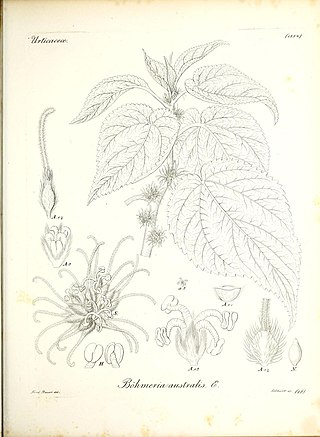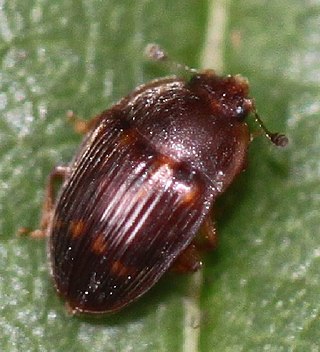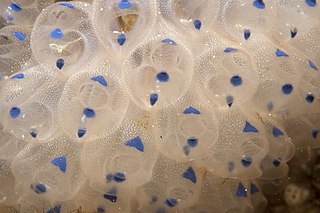
Ostriches are large flightless birds. Two living species are recognised, the common ostrich, native to large areas of sub-Saharan Africa, and the Somali ostrich, native to the Horn of Africa.
Platypterygius is a historically paraphyletic genus of platypterygiine ichthyosaur from the Cretaceous period. It was historically used as a wastebasket taxon, and most species within Platypterygius likely are undiagnostic at the genus or species level, or represent distinct genera, even being argued as invalid. While fossils referred to Platypterygius have been found throughout different continents, the holotype specimen was found in Germany.

Posidonia is a genus of flowering plants. It contains nine species of marine plants ("seagrass"), found in the seas of the Mediterranean and around the south coast of Australia.

Silvanidae, "silvan flat bark beetles", is a family of beetles in the superfamily Cucujoidea, consisting of 68 described genera and about 500 described species. The family is represented on all continents except Antarctica, and is most diverse at both the generic and species levels in the Old World tropics.

Nihonia is a genus of sea snails, marine gastropod mollusks in the family Cochlespiridae.

Amanita australis is a species of fungus in the family Amanitaceae. It produces small- to medium-sized fruit bodies, with brown caps up to 9 centimetres in diameter covered with pyramidal warts. The gills on the underside of the cap are white, closely crowded together, and free from attachment to the stem. The stem, up to 9 cm long, has a ring and a bulbous base. The mushroom may be confused with another endemic New Zealand species, A. nothofagi, but can be distinguished by differences in microscopic characteristics.

The Burrunan dolphin is a proposed species of bottlenose dolphin found in parts of Victoria, Australia first described in 2011. Its exact taxonomy is debated: numerous studies support it as being a separate species within the genus Tursiops and occupying a basal position within the genus, with limited phylogenetic studies using different methodologies indicate that it is a subspecies of the Indo-Pacific bottlenose dolphin. The Burrunan dolphin is not currently recognized as a species by the Society for Marine Mammalogy or American Society of Mammalogists, which cites problematic methodology in the original study proposing species status and recommends further research.

Phloeolaemus is a genus of beetles in the family Laemophloeidae, containing the following species:

Monotomidae is a family of beetles in the superfamily Cucujoidea. The family is found worldwide, with approximately 240 species in 33 genera. The ecological habits of the family are diverse, with different members of the group being found under tree bark, in decaying vegetation, on flowers and in ant nests. Their ecology is obscure, while at least some species are mycophagous, feeding on the fruiting bodies of ascomycete fungi, Rhyzophagus are predators on bark beetles and possibly Phoridae larvae, with the larvae of some species also being mycophagous.

Pouzolzia australis, synonyms including Boehmeria australis and Boehmeria calophleba, is a species of large shrub or small tree in the plant family Urticaceae. It is endemic to small islands belonging to Australia and New Zealand – Norfolk Island, Lord Howe Island, and the Kermadec Islands. The population on Norfolk island, sometimes treated as a distinct subspecies, is critically endangered. In the Kermadec Islands, it was described in 2018 as "threatened – nationally endangered".

The Australian bandfish is a species of bandfish in the family Cepolidae. It has been reported from the Indo-Pacific coastal regions of Australia, New Zealand, and New Caledonia, although some of these records may represent confusion with other species.

Epicaerus is a genus of broad-nosed weevils in the beetle family Curculionidae. There are more than 90 described species in Epicaerus, found in North America and Central America.

Dociostaurus is a genus of grasshoppers in the family Acrididae, subfamily Gomphocerinae and typical of the tribe Dociostaurini. Species are found in Africa, southern Europe and Asia, and includes the economically important Moroccan locust.

Neocylloepus is a genus of riffle beetles in the family Elmidae. There are about eight described species in Neocylloepus.
Grossoseta is a genus of flat-footed flies. There are at least two described species in Grossoseta.

Stelidota is a genus of sap-feeding beetles in the family Nitidulidae. There are about 15 described species in Stelidota.
Jean Boag Struthers, née Cunningham, was a botany student in New Zealand and an inspirational chemistry teacher in England and New Zealand.

Callanthias australis, the magnificent sea perch, splendid perch, glorious groppo or Northern splendid perch, is a species of marine ray-finned fish belonging to the family Callanthiidae. This species is found in the southeastern Indian Ocean and the southwestern Pacific Ocean.

Clavelina australis is a species of colonial ascidian from Australia, in the family Clavelinidae.

Caccothryptus championi is a species of minute marsh-loving beetle in the subfamily Limnichinae. The species was described alongside five other Caccothryptus species by Natural History Museum entomologist Keita Matsumoto in 2021, using specimens gathered in 1953 by Harry George Champion in Haldwani, India alongside an earlier 1925 specimen collected nearby. Like the other Caccothryptus species described by Matsumoto, it was distinguished from its original classification of C. ripicola due to differences in the shape of its genitalia. Twenty-seven specimens from the British Natural History Museum collection were identified with C. championi, named after Champion.
















